Canada Craft Year 2020
December 11, 2020
Greetings from Canada! The Canadian Crafts Federation / Fédération Canadienne des métiers d’art has declared 2020 as a year-long celebration of Canadian fine craft. In Craft Year 2020 member artists are encouraged to push themselves to do something new. In our monthly newsletters, Susan M. Clark (SDA Membership Committee) highlighted a Canadian SDA member from a different province or territory, and here’s a spotlight on those selected artists!

January: Alberta
Angela Dale, of Fabricadabra Creations, lives in Black Diamond, Alberta, north of western Montana. The breadth, scope and beauty of Angela’s work in theatre, film, dance, opera, fashion and technology is awe-inspiring. Her website exclaims that she is “passionate about the role of design in performance.”
Angela is very active in technology and fashion. She lives outside Calgary, which boasts a sophisticated and sizable fashion technology community. A key component of which is the Make Fashion collective. Each year Make Fashion holds a fashtiontech event. This launches new collections of innovative fashion where: “The combination of skills and ideas creates stunning results and groundbreaking fusion of light, fashion and performance.” Angela Dale’s work has been featured at CES, or the Consumer Electronics Show, the proving ground for innovation which colonizes Las Vegas every January.
Angela has an extensive background in costume design. In 2017 and 2018, she created costumes for dance performances choreographed by Davida Monk. Reviewer Stephan Bonfield wrote of the six costumes created for Ashes for Beauty, “Angela Dale’s capes for the opening were designed to be culture specific, but when whipped around as the dancers snapped their bodies from side to side, making jagged arm movements through the air, they created a timeless sensation of an ever-evolving, inner emotional, theatrical spectacle.”
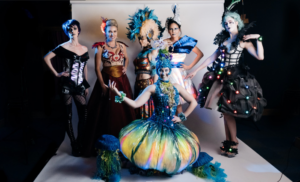
Fashtiontech costumes.
February: Saskatchewan
Lindsay Embree is from Saskatchewan. Initially, Lindsay worked primarily in lithography and etching. While at the University of Saskatchewan, she studied “waterless lithography,” a more environmentally friendly technique, developed by Nik Semenoff.
Since 2005, Lindsay has participated biennially in CollaboratioNZ where 85 artists gather to create art. While in New Zealand, she dyes the silk and merino yardage for garments later created in Canada. She uses the Eco-Colour Dye Method she learned from India Flint at the 2011 SDA conference, using eucalyptus and native NZ plants.
Lindsay recently co-produced Ancient Elements, a performance combining wearable art, original poetry, live flamenco-gypsy music and flamenco dance. With Lindsay’s hand dyed textiles, one-of-a-kind works of wearable art were created by designer/seamstresses Astri Prugger (Montreal), and Melissa Squire (Saskatoon). On three occasions, Lindsay coordinated the Saskatchewan Wearable Art Gala (SWAG), an event inspired by the World of Wearableart (WOW) in NZ. The SWAG fund raiser was generously underwritten by her and her husband with proceeds going towards the development of the Jack Millikin Centre for cultural and ecological events. It is in this boreal forest location at Ness Creek, SK that the biennial EMMA International Collaboration takes place, and where Lindsay has spent the last four events as Resource Artist for printmaking.
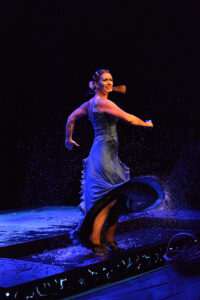
Lindsay Embree Como el Agua, natural indigo, wax resisted, dyed. Designed: Astri Prugger, sewn: Lyndsay Doig, dancer/model: Maria Regnier.
March: Yukon
Lyn Fabio is from the Yukon, the smallest and westernmost of Canada’s three territories. Despite its subarctic climate, the Yukon, home to Canada’s highest mountain, is a place of incredible natural beauty. Lyn graduated with a B.Ed. in Fine Arts (printmaking) in Montreal, then followed friends to the Yukon. She quips, “If you survive a winter in the north, you are hooked.”
To support her art making, she also trained as a chef. Lyn works in both gut and fiber. She has experimented with an incredible range of materials such as berry juice, geese feet, quills, and caribou and moose gut. It started in 1988: Lyn happened upon an exhibit curated by Pat Hickman titled Innerskins, Outerskins where she was overcome by “the luminous atmosphere, the otherworldly light seeming to emanate from within the creations there.” Lyn describes Hickman, a prominent conceptual fiber artist, as the “guru” of contemporary gutwork, and this month, she will attend a workshop led by her at the Schack Arts Centre in WA. The introduction to gut also introduced Lyn to the amazing tradition of seal gut parkas, a durable, warm garment made with local materials. Lyn adds, “I am very fortunate to actually have one, acquired through an exchange for my artwork with an elderly woman.” It was many years later when Lyn attended a workshop by Jill Nordfors Clark that she began her own exploration. She has traveled to Siberia on a cultural exchange, and also participated in the 2009 Cheongju (Korea) International Craft Biennale. Most recently, Lyn received an “Advanced Artist Award” of $10,000, from the Government of Yukon, to support artistic development.
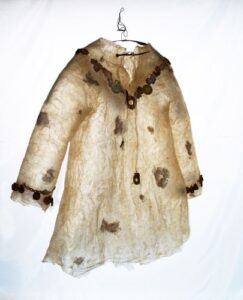
Lyn Fabio Road Warrior Spirit Shirt, layered hog gut, flattened rusty bottle caps, wire bits, embellished. Photo: Mario Villeneuve.
April: Nova Scotia
Wilma Butts is from Nova Scotia, the country’s second most-densely populated and second-smallest province by area. Nova Scotia is almost fully surrounded by ocean, with the Bay of Fundy and the Atlantic. “My colour palette is absolutely informed by nature in Nova Scotia…gardens, forest, coastline, ocean,” explains Wilma.
Wilma’s artwork involves shibori, “I bind, stitch, twist and pleat the fabric to create texture and then lock this texture into the fibre. I use these amazing textured materials to create sculptural artwork…and artwear.” One of her sculptural pieces is on the front cover of the 2018 coffee table book, Dimensional Cloth, Sculpture by Contemporary Textile Artists by Andra F. Stanton. The same piece, “Anemone” was also featured in the 2009 Cheongju International Craft Biennale.
I was curious about how Wilma got started with shibori and she explained, “In 1998, I discovered Yoshiko Wada’s book Shibori, The Inventive Art of Japanese Shaped Resist Dyeing, and I was fascinated by the textile traditions and the wonderful patterns that could be created. In the course of exploring traditional techniques and patterns, I became fascinated by the textures that were created by many of the processes. That discovery inspired my use of shibori textured fibre as a sculptural medium.
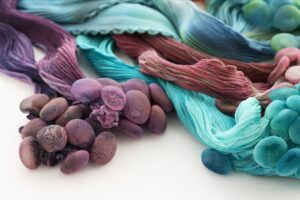
Wilma Butts Anemone (detail). Photo: Perry Jackson.
May: Québec
Tina Struthers work is exhilarating in shape, texture, and colour. She says her process “is anchored in creating sculptural forms and clothing them in contrasts. Through shredding, cutting and then destructive manipulation of textiles, scars and wounds are created that are then often mended with hand stitched and layered fabric elements.”
Tina is from Québec, Canada’s largest province, where French is the sole official language. Tina learned French when she moved to Québec in 2011; in 2008 she immigrated from South Africa with a fine arts background, having studied at Pretoria’s Open Window Academy.
All of us have been affected by these unprecedented times. In Tina’s case, she had a major solo exhibition “Codex II” set to open on March 19 at Halifax’s Mary E. Black Gallery: “Struthers’ large-scale textile sculptures and murals explore the uncertain and mutable consequences of humans on our environment. Her personal experiences and observations of immigration and human dis/placement are reflected in the forms and surface treatment of her work.” This show will be rescheduled.
Tina also has a piece l’écoulement in the 16th International Triennial of Tapestry in Łódź, Poland, where this show has been extended until July 27, 2020. The Canada Council Arts Abroad program assisted Tina in attending the opening. In addition to steady, hard work, Tina benefits from living in a province where the arts are enthusiastically supported. Tina explains, “Cultural and artistic events and activities are a very important part of community life here.”
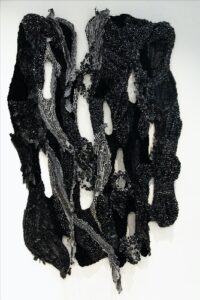
Tina Struthers l’ecoulement 2018, leather, VHS tape, velvet, buttons, silver wire, 78″ x 59″ x 4″.
June: New Brunswick
Linda Brine is from New Brunswick, one of four Atlantic provinces, and the only bilingual province. Linda, a fibre and book artist, spent 22 years in New Brunswick. She was the Fibre Arts Studio Head, and instructor, with the New Brunswick College of Craft and Design for ten years.
Linda is most well known for her weavings using an adapted Japanese Saga Nishiki technique. In 1997, Linda brought Japanese master weaver Mihoko Karaki to Fredericton, NB, to present a nine-day workshop which forever influenced Linda’s artwork. “It solved a lot of technical problems I’d been having weaving paper, and since then my work has been more resolved,” Linda states.
“Saganishiki is an elegant ornamental cloth originally created by Tokuko Nabeshima, the wife of a power feudal clan leader,” wrote Linda in the Canadian Guild of Weavers newsletter. Originally secret, it is a unique form of brocading that uses Japanese paper, coated in gold, silver, or lacquer as the warp. The weft is a dyed silk thread. Linda quotes Mihoko, “Not only was the weaving a pleasurable pass time . . . but more importantly, it was regarded as a spiritually fulfilling practice . . . the weaver was expected to empty her mind of all troubling thoughts so that the weaving filled all of her consciousness–thus creating the special aesthetic awareness that is termed ‘wabi’ in Japanese.”
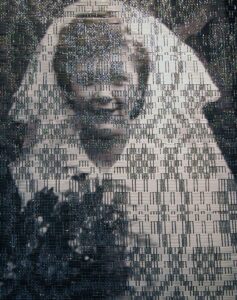
Linda Brine Portrait: Camille Claudel 2019, appropriated image on paper(warp) /metallic and holographic threads (weft), Saganishiki adaptation, 10″ x 8″.
July: Manitoba
Rosemarie Péloquin from Manitoba, lives in a small French-English village an hour’s drive from the main city of Winnipeg. Rosemarie found her artistic medium of hand needle-felting about five years ago after allowing herself time for broad artistic exploration. She poetically describes the process, “Hand needle-felting uses… three-inch needles to sculpt wool and fibre… Repetitive stabbing of the wool with the notched needles hooks and entangles the fibres to mesh them together… For hand needle-felting it is better to sit still, concentrate and heighten your awareness of all sensations… If you pay attention, the sound and feel of the wool will tell you when you need to stop or redirect.”
Seldom have I encountered an artist so harmoniously attuned to the material, “The sensuous wool lends itself so well to sculpture,” and the final artwork. “I start with an expression or feeling,” explains Rosemarie. She goes on to say, “I am often surprised by what surfaces. The expression may change with a few strokes of the needle… Age and gender seem to morph as I work on a piece.”
Recently, Rosemarie has been sculpting hands, which she sees as expressive and telling a story. The hands take on another dimension in this time when the pandemic prohibits touching. Rosemarie also collaborates with other artists and a recent series includes felted hands paired with hand-made books by book artist Debra Frances Plett.
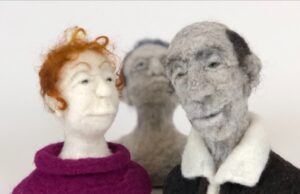
Rosemarie Péloquin 3 pieces from the series The Neighbour/Le voisin 2020, natural and dyed wool batt, locks and roving, needle-felted wool sculpture, approximately 7″ x 6″ x 4.75″ each.
October: Ontario
Carol Howard Donati is from Ontario, Canada’s most populous province. She lives in Ottawa, which in addition to being a large urban centre, also has significant unique wetland, forest and woodland habitats. It is this natural environment that strongly influences Carol’s most recent art making.
Carol, who has Master’s degree in Anthropology and recently completed a Masters of Fine Arts, has been conducting a long-term study of two wetland areas within 100 kms of our country’s Parliament buildings. Walking and photographing in these unmanaged greenspaces close to urban habitation provides inspiration for her artworks that “emphasize our lack of separation from nature and our sharing of a compromised global environment”. Carol creates artwork that “contrasts human-made with organic forms to disrupt normal ways of seeing and engage uncertainty.”
Exhibiting since 2011 both locally and internationally, Carol truly is interdisciplinary using a wide array of materials and processes including photography, sculpture, installation, and video. In her recent work she combines site-specific organic materials such as shells, clay and waterweed with domestic cast-offs such as linens, plastics and construction debris. Such combinations “draw attention to layers of unseen action and undervalued histories within the everyday”.
Carol has a wonderful way of challenging our familiar perceptions of nature. It’s refreshing and hopefully prompts us to reconsider our managed world. She shares, “What I have learned in my outdoor explorations is our lives worlds touch and influence each other via the larger ecology we share, yet nature exceeds what is possible for us to know.”
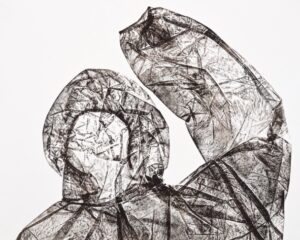
Carol Howard Donati Dangers of denial 2019, ink, Fabriano paper, monoptype using inked hazmat suit, 22″ x 30″.
November: British Columbia
Anni Hunt is from British Columbia. The pandemic has free up West Vancouver artist Anni Hunt to do more creative work. Her artwork has thrived, and she’s been in two exhibitions this year in addition to several online shows. Anni is one of four artists included in a Sunshine Coast show, Shifting Landscapes, showing work inspired by the natural beauty of the West Coast and paying homage to textile traditions. Anni is a mixed media artist who makes abstract textile pieces that are painted and embellished.
Recently on her blog, she has posted photos of brushes she has made along with abstract pieces painted using the brushes. Some SDA members may know Anni from her YouTube channel with 1.8K subscribers. Anni has made 22 videos on a variety of sewing techniques including one showing how she organized her studio. Anni says, “My sewing tutorials on YouTube were fun to do, but a lot of work, my videographer worked tirelessly to edit them and get them up to standard…since Covid, my time has been freed up somewhat…so I think it may be time to do some more.”

Anni Hunt Barren Lands 2020, ink, oil, gouache, linen canvas, painted, hand and machine stitched, 24” x 36”. Photo by the artist.
December: Pender Island
Monica Bennett is from Pender Island, specifically in an area called Magic Lake on Foc’sle Road! The island community has a population of 2,250. Monica has been working with handmade felt since 2001. She makes sculptural, wearable, and framed art with silk chiffon and wool, both of which hold colour beautifully. “Now that I am focussing more on sculptural pieces, I’m incorporating silk chiffon as a surface design element… creating a beautiful texture,” Monica explains. Monica has taken a break from art making during the pandemic but challenged herself through further education and curation.
In March, Monica enrolled in Jane Dunnewold’s ten month online Creative Strength Training, where this year’s theme has been ‘Working in a Series.’ Monica elaborates, “I have learned so much about myself, how I make art (or avoid making it), and how my archetypes either benefit or obstruct my work… The course has kept me connected with other artists, their creative journeys and their artwork and, in turn, they have encouraged me on my journey.” Monica was a founding member of an artisans’ cooperative on Pender Island, and recently she has curated a show titled “Movement” for the Gallery at Ptarmigan Arts.
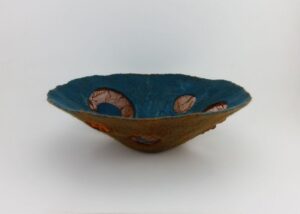
Monica Bennett Copper-nicus 2017, merino wool, silk chiffon, wet felted, resist technique, 3” x 9.5”. Photo by the artist.



Related Blog Articles
Angela Dale
Member Spotlights: 2020
Angela Dale
Member Spotlight: Angela Dale